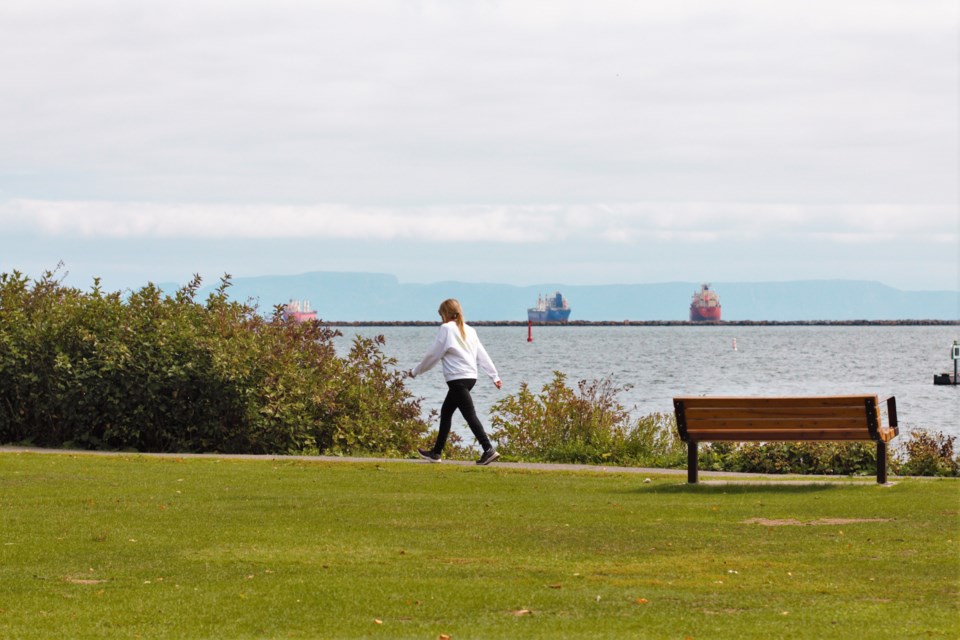THUNDER BAY — A city councillor is pushing the city to put money on the table in hopes of kick-starting an ambitious waterfront trail project.
City council will debate a motion from Coun. Trevor Giertuga to set aside $3 million for the project on Monday.
His motion stipulates the money would only be spent if the city can secure matching funds from the provincial and federal governments, and potentially the private sector, to construct a $9 million bridge in the Current River area.
The bridge is considered a key piece of the waterfront trail plans, forging a walking and cycling link between Prince Arthur’s Landing and amenities like Boulevard Lake in Current River.
The bridge would connect Marina Park Drive and Shipyard Road by passing over railway tracks that serve the Richardson grain terminal.
A flyover video produced for the Waterfront Trail Rotary Community Action Team (WTRCAT) by Steve Robinson shows the proposed route for the first phase of the trail, including the proposed bridge.
The Rotary group had called on council earlier this year to move ahead with the city’s vision of a 13.5-kilometre trail that would unite the city’s north and south ends.
The trail will require huge investments, estimated at well over $20 million, and will depend on negotiations with numerous private property owners. Some councillors have expressed skepticism over a proposed route that travels through industrial areas removed from the waterfront.
Others including Giertuga have enthusiastically championed it, however, saying it will help revitalize the city’s waterfront and foster economic growth.
The WTRCAT group released a feasibility study earlier this year that suggested the trail could bring significant economic benefits, and boasts strong public support.
WTRCAT team lead Warren Philp called the bridge at the Richardson terminal a key piece of that vision, connecting Prince Arthur’s Landing with popular recreation assets like Boulevard Lake, Centennial Park, and the Shuniah Mines.
“I don’t think you’d find an active living person in the city who wouldn’t immediately understand the significance of that linkage that is lacking right now,” he said.
For Giertuga, the project is a way to modernize Thunder Bay’s waterfront and compete for tourism dollars.
“We have 52 kilometres of waterline,” he said. “Why aren't we developing it? I mean, look at other cities that have developed their waterfront, and you can go for miles along the waterfront and rollerblade, walk.”
However, he emphasized that the dollars will only be spent if matching funds are secured. His motion also specifies that the city’s $3 million commitment would expire at the end of the current council’s term in 2026.
The money would be allocated from the city’s Renew Thunder Bay fund, which is intended to leverage matching funding for projects that encourage tourism and economic growth.
The fund currently contains around $17 million, Giertuga said.
“I'm not one to quickly spend money. I’m always trying to be that [guardian] of the public tax purse,” he said. “But it’s on our infrastructure list, it’s on a long-range plan for administration, it’s something we plan to do anyways.”
Giertuga also noted the waterfront trail is included on the city’s infrastructure priority list.
Asked if the expensive project is worthwhile at a time when the city is facing serious financial challenges, Philp argued the investment of Renew Thunder Bay dollars is likely to pay off, pointing to prior spending on Prince Arthur’s Landing as an example.
“That reserve fund has been set up for legacy-type projects, and when one looks at the work that’s already been done at Prince Arthur’s Landing, I think the city has a great legacy project there, and it keeps growing, with respect to investments such as Science North, the Thunder Bay Art Gallery, and the advent of the cruise ship industry.”
Philp emphasized that while WTRCAT intends to support the trail, it remains a city project, and the city would be responsible for applying for provincial and federal funding.
However, he expressed optimism that government funding could be forthcoming.
"Based on the conversations we've been having, we think the provincial and federal dollars will follow the city commitment," he said. “This type of project, with the city spending 33 cents on the dollar, is a pretty wise investment when one looks at the economic and tourism impacts the project will have, not to mention the benefits that will accrue to the citizenry of Thunder Bay.”
